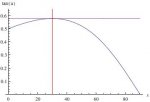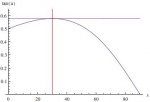Alas, I don't know how feasible it is to generate a blackhole of any size, let alone move it.
Hopefully this is all fun. I see some of you have gone deeper into math with flagpoles and cars.
The new problem is actually old to me. It seemed like a good idea and is the basis of a heroic scene. I've skimped on details.
The bad guy has an AR15 because of Reasons(TM). He's going to shoot a lot of unsuspecting people over yonder.
The hero steps in the way, let's say 10 feet in front (give or take, I had to assume the turret isn't setup right at the edge). This helps block LOS and sucks up some bullets if the real plan doesn't work.
The real plan is that there are high speed cameras, computers and a rapid firing railgun launching matter to deflect the bullets from some unknown position.
The tech can fire at the speed of plot. It is not allowed to kill the bad guy, for Reasons(TM). The hero doesn't love this plan, and would appreciate a second opinion.
Is it plausible that the bullets can be shot out of the air such that nobody gets hurt, including the hero?
PS. It is simply coincidence that both of these are deflection problems. I worked out this situation a few years ago, and am trudging through the rewrite of the novel to finally get to write this bullet scene. The Asteroid story came up this year.
There is no real reason you can't shoot a bullet out of the air with sufficient tech.
It's sort-of how phalanx guns work to intercept missiles. It's more can the apparatus to do so be close enough to intercept before the bullet hits the hero. That is going to be tricky.
The constraints for interception are how accurately can you gauge the target's trajectory, how quickly can you get something to intercept the bullet, and how much deviation do you need to impart to its momentum.
The further the bullet can be allowed to travel before launching a counter, the better your trajectory prediction can be. The longer the travel time of your interceptor, the better your prediction needs to be. The further the travel time of the bullet after the interceptor hits, the less deflection you need.
The constraints on distance of interceptor device is how long does it take to develop a target solution, how
long does it take to accelerate the interceptor, and what is the flight time to intercept.
Let's start with what we know. an AR-15 bullet travels at about 1,100 metres per second. It will reach the hero in about 3/1,000 of a second after clearing the barrel.
Acquiring a trajectory is likely to take at least two images. A very high end commercial camera shoots about 16,000 frames per second (a truly astounding single-purpose camera can shoot a trillion frames per second but isn't fit for purpose). Assume we get something just above that. So you lose the first 1/8000 of a second gaining the trajectory. We'll assume the computer effectively takes zero time to calculate a response trajectory.
Let's accelerate the interceptor at 1000 g to a maximum speed of Mach 10 (4,000 metres per second). That takes 4/10 of a second. Oops. That didn't help. Assuming we have zero flight time, and needed to hit Mach 10, the necessary acceleration would be more than 1,500,000 g. ( t = (3/1000 - 1/8000), v = 4000, a = v/t) to strike before the bullet hits the hero. Because we don't care overmuch, let us increase the acceleration to 15,000,000 g and simply stipulate the interceptor isn't destroyed of deformed by the forces. That costs us about 1/4000 of a second. That leaves us with 1/400 of a second to intercept. At 4,000 m/s the interceptor would have to be no more than 10 metres away. Which is probably too close. So let's increase both the acceleration and final speed 10-fold. The inceptor is now accelerated at 150,000,000 g to a maximum speed of 40,000 m/s (past the point of ridiculousness in both cases). Because both acceleration and velocity increased by the same multiple, the time remains the same so we are left with 1/400 second transit time so we can move the inceptor to 100 m away. Which is good because at those speeds, the interceptor is going to burn up in the atmosphere like a miniature meteor.
Let's assume for safety's sake we need to change the bullet's trajectory 45 degrees. Call the bullet 5 grams so the forward momentum is 5 Newton seconds. Since the interceptor is traveling at 40,000 m/s, it's mass must be at least 0.125 grams for a perpendicular hit.
This scenario suffers from the same problem as the meteor one -- the projectile is just too close to its target. Interception works much better when there is time to respond.




